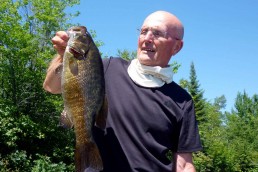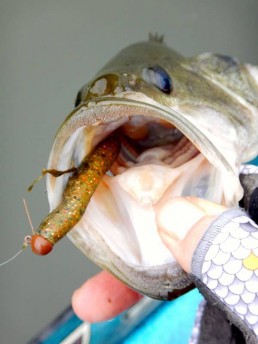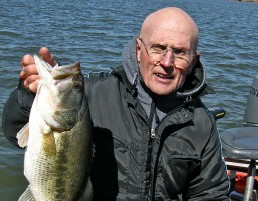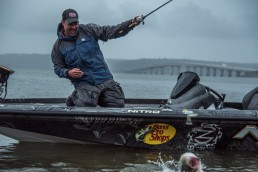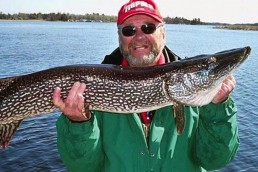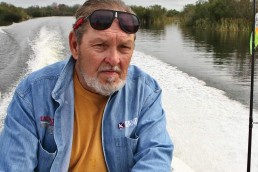In His Own Words… Ned Kehde: Passionate Teacher of Finesse Bassin’
SHARE THIS POST
If you’re near water any weekday in northeastern Kansas, you might spot Ned Kehde launching his 16-foot, tiller-powered Alumacraft behind his white station wagon. Kehde, a lean athletic fellow, is soon in the boat brandishing an 8-foot piece of PVC pipe that’s capped on both ends. One end is metered with electrical tape every foot. Kehde pushes away from shore with the metered end, using it to gauge water clarity.
This is one of many details he’ll note, just like every day he’s on the water.
After recording the clarity reading, he takes out a digital kitchen timer and starts it. Next to the timer he lays a round metal “tally counter” of the sort that bouncers in front of taverns use to count how many patrons enter. Kehde clicks the button with every bass he catches, no matter the size. His goal today—like every day—is to catch and release 25 bass an hour, aspiring to achieve 101 in the course of the four hours he’ll pilot the fishing boat with its hand-steered, Minn Kota bow-mount trolling motor, often dragging a drift sock to compensate for the ubiquitous prairie winds.
Within easy reach are four or five identical 6-foot spinning rods with Cardinal 4 spinning reels, with the bails removed. He’s more efficient because he doesn’t have to open or close the bail. You won’t see much of a splash from the lures he tosses at the shore just 30 to 35 feet away. He tempts bass with variations of what has become known as “The Ned Rig,” mushroom jig heads of either 1/32 or 1/16 ounce, adorned with small plastic lures ranging in size from 2 1/2 to 4 inches.
These are tools of “Midwest Finesse,” for which Kehde is the standard-bearer, records keeper and all-around guru. When he gets home after four hours of fishing he’ll share his log with his ‘”Finesse News Network,” an email list, which anyone is welcome to join by dropping Ned an email at nkehde@ku.edu.
Few folks would guess him to be 76, and he claims to feel better now due to diet and exercise. He has been telling the world about the effectiveness of the little lures for years—he’s been a devotee since he first saw the small lures catch bass back in the 1950s.
Let’s get to know this fellow with as much passion for teaching others about fishing as for catching fish himself.
Here we go, with Ned Kehde, in his own words:
MidWest Outdoors: Where did it all start for you?
Kehde: When I moved out of St. Louis, we moved to Sedalia, Mo., about 25 miles from Lake of the Ozarks. My father, grandfather and my uncles in ’47 and ’48 took me down to a place called Cole Camp Creek on the upper end of Lake of the Ozarks. We waded those streams, fishing primarily with crayfish on a number 2 hook and split shot, catching spotted bass and largemouths. And a few of those feeder creeks had smallmouths in them. It kind of sparked a little interest in me. My grandfather fished a lot and would go to Minnesota every summer around Nisswa from the ’20s to the ’40s. In the late ’40s, my parents started going on vacations around Nisswa. We stayed at Minnewawa Lodge on Clark Lake and we fished all the area lakes. I just had a natural tendency to fish. In 1953, Fred Pothoff, an aggressive bass fisherman and guide, asked me to “row the boat.” Back then the guide was a boat rower. We rowed the boats along the bulrushes and later in the summer the cabbage would grow and little red tops would stick out of the water. We used to call them red top bars, and we’d ply the outside edges. Mainly, we were using live leopard frogs in those days, but as time went on, we started using the Abu straight-line spinner and the Heddon Sonic. The last few years when I was still in high school, I got my first use of a marabou jig. It must have been about 1/8 ounce because we weren’t using spinning tackle then. We were still using casting tackle. That’s how I got into it.
MWO: Did you ever dream of making a living in fishing?
Kehde: Never dreamed of it. I write, but just for the fun of it now. I guess it’s a passion. That’s a strong word for it, but what I want to do is teach people how to catch fish. I just want to tell them how I’ve been doing it. It has been pretty successful. We kind of aim to catch 25 bass an hour and don’t always do that you know—like I fished on Monday at a local community lake and we ended up catching 61 in four hours, and that is a fairly respectable day. From January to December we average about nine to 10 fish an hour.
MWO: That kind of segue-ways into why we’re talking to you. You were, I guess, using Midwest Finesse tactics and the Ned Rig?
Kehde: Yes we were—that’s all I use anymore.
MWO: Take us back 10 years when you first fished what has become the main “Ned Rig.”
Kehde: That was a Zero, sold by Strike King Lure Company, now made by Z-Man. Back in 2006, in October I went down to a media event at Table Rock Lake that Nitro Boats and Bass Pro Shops put on. In-Fisherman asked me to go down and cover it. Kevin VanDam was there, and I wanted to do a little story on fishing the shaky head worm jig because back in 2006 it was a pretty predominant phenomena going on the B.A.S.S. and FLW circuits. So I watched VanDam fish a little bit and he gave me a bag of the Zeros. They’re a 5-inch, straight-worm bait, pretty much shaped like a Senko. About a week or two later I was down at a small community lake here in Kansas, fishing with another guy and I pulled out these things, because back then we were using 3-inch Gary Yamamoto Senkos and Yum Dingers.
MWO: You were pairing those with what size jig?
Kehde: We were using a 1/32- and 1/16-ounce jig. We used a Gopher Jig made in Minnesota. That 1/16- ounce one is a phenomenal jig—my favorite jig of all time. So I pulled this package of Zeros out and it was a 5-inch lure, way too long for us. It was difficult to cut in half; it’s really tough stuff. Finally, I stuck half of it on a 1/16-ounce red Gopher Jig and started catching ‘em. I gave one to my friend and he started catching and we caught 109 bass in four hours. And we still had the same baits on—the very same baits. In fact, I imagine we used that very same bait for several more trips. The most I’ve ever caught on one was a Z-Man Finesse WormZ, a 4-incher, and last year I caught 232 on it. These things last a long time, and the older and more tattered they get they seem to catch more. It’s a great bait, and I don’t know why it is.
MWO: They’re made out of a different kind of plastic, right?
Are you enjoying this post?
You can be among the first to get the latest info on where to go, what to use and how to use it!
Kehde: Yes they are. It’s called ElaZtech. And it’s a different kind of plastic. They do inject salt into some of the baits. I, and some of us Midwest Finessers—we like to remove some of the salt.
MWO: And how do you do that?
Kehde: We soak ‘em in hot water and stretch them out. Other times, guys will just fish them for a while and the fish stretch it. They will become buoyant. One of our main factors is the no-feel retrieve. That buoyancy makes the bait glide and you don’t have any idea where that bait is in relationship to the bottom. Most bass fishers, they want to feel that bait on the rocks, on the bottom; they want to feel that bait all the time. We have found that the more you feel it, the less fish you catch. The less you feel it, the more fish you catch. It’s just one of those phenomenon and I don’t know why that is either, but “no feel” sits at the heart of our way of fishing.
MWO: The ZinkerZ is one type of Ned Rig and it might be the original Ned Rig. But what other types of lures are now called the Ned Rig?
Kehde: Primarily, Z-Man has had a monopoly on these things. One of my favorite baits is called the Finesse ShadZ. It is very similar to the Gary Yamamoto shad-shaped worm. But a Gary Yamamoto shad-shaped worm—on a good day—will catch you three to four fish before it’s disintegrated. You can catch them on a finesse ShadZ—I’ve caught 100 on some of those baits. We’ve been using these things since 2011 and I have some of them that I got in 2011. In fact, I was fishing some on Monday, a pearl one, and it was one of the most effective baits. Then Z-Man started making a bait they call the Finesse T.R.D., a 2 3/4-inch stickbait, and it’s made to replace cutting the ZinkerZ in half. I use it every once in a while, but I still prefer the ZinkerZ because I’m an old man and I have an allegiance to the old stuff. Other guys say I’m kind of nuts, but I just do.
A friend of mine who lives down the road in Rantoul, Kans. was an original Midwest Finesser in the ‘70s, but he kind of got away from it until we got together again in 2010. He got hip to it too and he’s been working with the guys at Z-Man to make a bait that he designed, the Hula StickZ. It’s a 4-inch bait, a stickbait, and it has four tentacles kind of like a tube has. Drew Reese is his name and he’s a whale of a fisherman and he fishes that whole, 4-inch bait. I like shorter baits; I cut it down to maybe 3 inches. I like it cut, and I catch a lot of fish. He says it still catches a lot of fish up there in Lake of the Woods, Minnesota and Ontario, where he spends summers. I just feel more comfortable with the shorter one, so I cut it down. And now Z-Man has a new thing they call the T.R.D. TubeZ, which is a 2 3/4-inch tube bait. Tied with the Finesse ShadZ is the Finesse Worm Z, just a fabulous worm. I told you earlier that last year at this time in November and October I caught 232 fish on the same Finesse WormZ.
Listen to more with Ned Kehde when we pick up on the podcast, Kehde will expand on how to fish these tools of MidWest Finesse, and nuances of the various baits. He also delves into where the “Ned Rig” comes from, noting he never really wanted it named after him and feels like it should be named after the house painter Kehde calls the “true father of Midwest Finesse.” Find out who it is, plus a lot more on how you can become a proficient Midwest Finesser in the Podcast section at midwestoutdoors.com. On the home page, look for “Podcast” link, click on it, and you’ll find the interview. Look for it this month. We hope you have time to listen to some of our other episodes as well. We’ll see you there—it’s time well spent.
Kehde through the years
Born: April 27, 1940, St. Louis, Mo.
1947-48: The fishing bug bit when older relatives took him wade fishing in streams flowing into Lake of the Ozarks.
1950s: Spent summers in the Nisswa area of Minnesota at his maternal grandfather’s cabin on Lake Hubert and at Minnewawa Lodge on Clark Lake.
1953: Fred Potthoff, lodge owner and guide, asked to Kehde to “row the boat,” which is what guiding was called then. He saw the effectiveness of a small marabou jig then.
1965: While working toward advance degrees in history and library science at the University of Missouri, he guided weekends on Lake of the Ozarks and becomes friends with Guido Hibdon, future bass pro, who also became a proponent of small baits and spinning tackle.
1970: Kehde got to know Chuck Woods, a house painter with the reputation for catching more bass than anyone in the Kansas City area. Woods created the first Beetles, small plastic lures that worked on jig heads and as the body for Beetle Spin spinnerbaits.
1981: Kehde submitted his first story to In-Fisherman magazine, becoming a regular contributor, covering a wide range of fishing topics.
1980s and ’90s: Also begins writing for three area newspapers, continuing to focus on finesse fishing, having exceptional days of catching bass on 3-inch Yum Dingers and Yamamoto Senkos.
2005: Develops an aggressive form of urinary tract cancer that claims 85 percent of patients diagnosed with it. Surviving after surgery and treatment, Kehde adopts a healthy lifestyle of a natural-foods diet and a daily exercise routine. He begins teaching people how to fish pain-free.
2006: Bass pro Kevin VanDam gives Kehde a pack of Strike King Zeros, made of remarkably durable ElaZtech soft plastic. Kehde and a friend, each using half of a 5-inch Zero on a 1/16-ounce Gopher Mushroom Head, catch 109 bass in four hours on a small-town park lake without replacing the plastic worms.
February 9, 2012: Kehde and his cousin record 120 bass in four hours, a benchmark outing.
MWO
SHARE THIS POST
Did you enjoy this post?
You can be among the first to get the latest info on where to go, what to use and how to use it!
Dave Mull
Dave Mull of Paw Paw, Mich. has spent his career communicating the outdoors experience and runs Inner Viking Media. He enjoys kayak fishing for anything that swims in the lakes and rivers of the Midwest and beyond, and even uses his MirroCraft, from time to time. Available for seminars.
